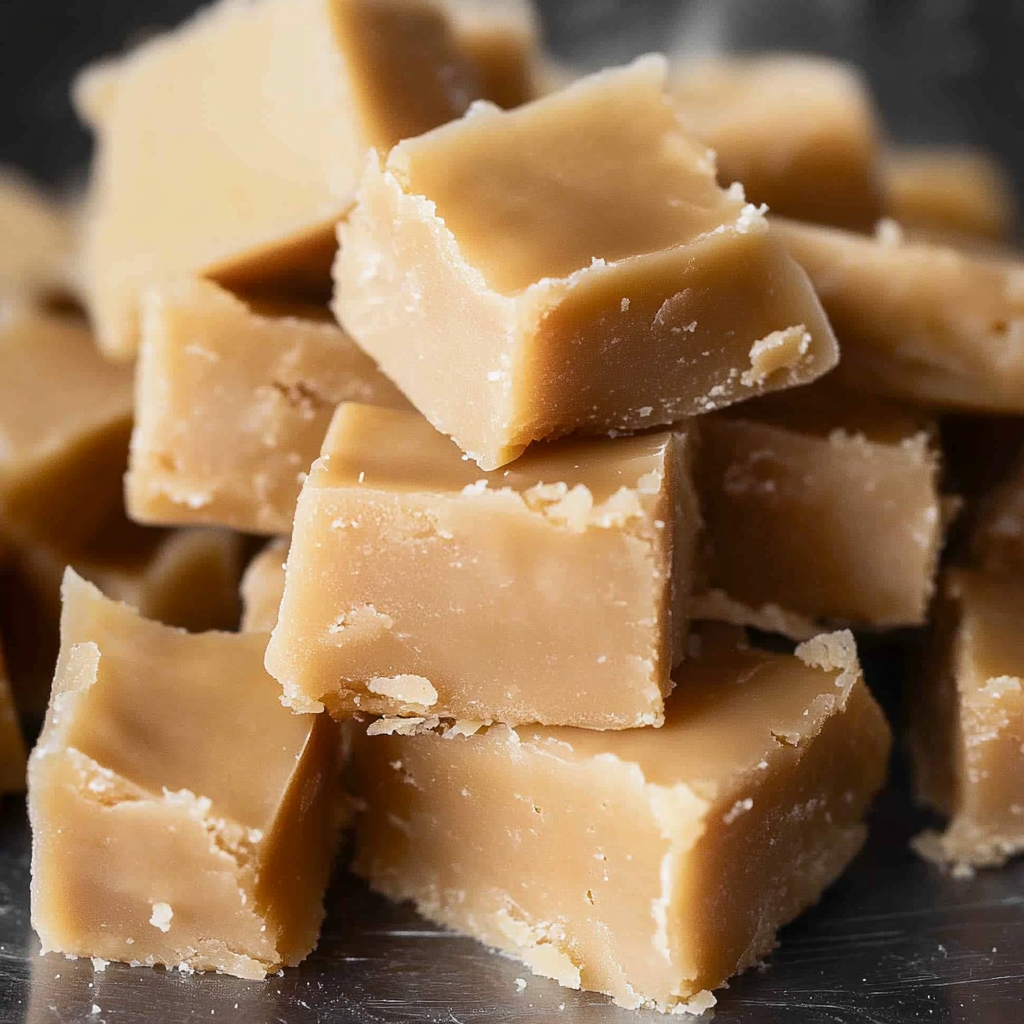Introduction
I’ve always had a sweet spot—literally—for anything caramel. There’s something nostalgic about the smell of bubbling sugar, butter, and cream filling the kitchen air that takes me straight back to childhood. I remember the first time I tasted real, homemade caramel fudge. It was during a holiday visit to my grandmother’s house. She had this little tin box lined with wax paper and filled with golden squares of caramel that melted in your mouth like warm hugs. That one bite sparked a lifelong obsession.
Years later, I decided to recreate that memory from scratch. And let me tell you, the first few attempts were… interesting. I had batches that were too soft, some that turned to rock, and one that glued my saucepan shut. But eventually, after lots of stirring and a few sugar burns, I cracked the code. Now this old-fashioned caramel fudge is a staple in my kitchen around the holidays—and sometimes, for no reason at all.
This fudge is smooth, creamy, and just the right amount of chewy. It’s the kind of treat that disappears quickly, whether you’re giving it away or keeping it all to yourself. I love making a batch, wrapping it in little boxes, and gifting it to neighbors or guests. Though I’d be lying if I said I didn’t sneak a few pieces before anyone else gets them.
Why You’ll Love This Recipe
Versatile
This caramel fudge is perfect for any occasion—holiday gifts, party favors, or just a sweet little indulgence after dinner. You can also add nuts, swirl in chocolate, or sprinkle a bit of sea salt for extra flair.
Budget-Friendly
You don’t need expensive equipment or rare ingredients. With just sugar, butter, and milk, you’ll create a luxurious-tasting fudge that rivals anything you’d find in a fancy candy shop.
Ingredients for the Recipe
-
2 cups granulated sugar
-
1/2 cup brown sugar, packed
-
1 cup evaporated milk
-
1/4 cup unsalted butter (plus extra for greasing)
-
1 tablespoon light corn syrup (or honey as an alternative)
-
1/4 teaspoon salt
-
1 teaspoon vanilla extract
How to Make This Recipe
Caramel fudge might sound intimidating, but trust me—it’s easier than you think. As long as you give it your attention and don’t rush the process, you’ll end up with smooth, melt-in-your-mouth fudge every time. The key is patience and a good candy thermometer.
Step-by-Step Instructions
Step 1: Prepare the pan
Before you start cooking, grease an 8×8-inch square baking pan with butter and line it with parchment paper, leaving an overhang on the sides. This makes it easier to lift the fudge out once it sets. Set the pan aside.
Step 2: Combine the ingredients
In a medium-sized, heavy-bottomed saucepan, combine the granulated sugar, brown sugar, evaporated milk, corn syrup (or honey), butter, and salt. Stir everything together over medium heat until the butter melts and the mixture looks smooth.
Step 3: Stir continuously until boiling
Once everything is combined, stir the mixture continuously. As it heats up, the sugar will dissolve and the liquid will begin to bubble. This stage is crucial—don’t walk away. You want to stir steadily so nothing sticks or burns on the bottom.
Step 4: Bring to soft-ball stage
Continue cooking the mixture, stirring frequently, until it reaches 115°C (240°F) on a candy thermometer. This is known as the “soft-ball stage.” If you don’t have a thermometer, you can test by dropping a small amount into a glass of cold water—it should form a soft, pliable ball when you roll it between your fingers.
Step 5: Remove from heat and let rest
Once it reaches the correct temperature, immediately remove the pan from the heat. Let it sit undisturbed for 5 minutes. Do not stir it during this time. This short rest helps reduce the chance of crystallization and gives you that smooth texture.
Step 6: Beat the mixture
After the resting period, add the vanilla extract. Then begin beating the mixture using a wooden spoon or a hand mixer on low speed. You’ll want to beat until it thickens slightly and starts to lose its gloss. This may take 6–8 minutes by hand. Don’t stop too early—the glossiness must go for a creamy texture.
Step 7: Pour and spread into the pan
Quickly pour the thickened mixture into your prepared baking pan. Use a spatula to spread it evenly into the corners before it sets. Smooth the top as best as you can, but don’t stress about perfection. It’s rustic!
Step 8: Cool and set completely
Allow the fudge to cool at room temperature for at least 3 hours, or until firm. You can speed things up by placing the pan in the refrigerator, but avoid the freezer—it changes the texture and can make the fudge grainy.
Step 9: Cut into squares
Once fully set, use the parchment paper to lift the fudge out of the pan. Place it on a cutting board and cut it into small squares with a sharp knife. Wipe the knife between cuts for clean edges.
Step 10: Store and enjoy
Store your caramel fudge in an airtight container at room temperature for up to 2 weeks. For longer storage, keep it in the fridge. It also freezes beautifully if you wrap the pieces individually.
Quick and Easy
Even though caramel fudge sounds like something you’d need a culinary degree to master, it’s actually very approachable. The entire process takes under an hour, not including cooling time. You’ll use common ingredients and a saucepan—no fancy candy molds, double boilers, or thermometers that cost a fortune. The biggest trick is to stir with care and watch your temperature.
Customizable
Want to mix it up? Add chopped pecans or walnuts right after beating the mixture. Prefer something fancier? Swirl in melted dark chocolate or top with a dusting of cinnamon. You can even sprinkle sea salt on top before it sets for a sweet-salty flavor explosion. For a twist, replace the vanilla with maple or almond extract.
If you’re dairy-free, you can experiment with plant-based butter and coconut milk, though you may need to adjust cooking times slightly. And for a chocolate variation, stir in 1/4 cup cocoa powder at the beginning.
Perfect for Guests
This fudge is a guaranteed hit. Cut into small squares, it becomes a luxurious little treat to serve after dinner or during coffee breaks. Arrange it on a festive platter or place a few pieces in a box with ribbon—it makes a perfect gift. Since it holds its shape well and doesn’t need refrigeration, it also travels beautifully for potlucks, parties, and holidays.
FAQs (Frequently Asked Questions)
Why did my fudge turn out grainy?
Grainy fudge often results from sugar crystals forming during the cooking or cooling process. To prevent this, avoid stirring once the mixture begins to boil. Also, allow it to rest undisturbed before beating. Make sure all the sugar is fully dissolved before boiling.
Can I make this without a candy thermometer?
Yes, though a thermometer gives the most accuracy. Use the “soft-ball test” by dropping a bit of hot mixture into cold water. If it forms a soft, pliable ball between your fingers, it’s ready.
Is there a substitute for evaporated milk?
You can use full-fat coconut milk or a thick plant-based alternative, though the taste and texture will vary. Avoid regular milk—it may curdle under high heat.
Can I double the recipe?
Yes, but use a larger saucepan to prevent bubbling over. Stir continuously and expect a slightly longer cooking time. Check the temperature carefully, as larger batches may take longer to reach soft-ball stage.
How long does it keep?
Stored in an airtight container at room temperature, the fudge will stay fresh for up to 2 weeks. For longer shelf life, refrigerate it, or freeze in small portions.

